MARIANI’S
October
31,
2010
NEWSLETTER

Adam Sandler and Kevin James in
"I Now Pronounce You Chuck & Larry" (2007)
Happy
Halloween!
~~~~~~~~~~~~~~~~~~~~~~~~~
➔ QUESTIONS? TO REACH JOHN MARIANI
WRITE
TO: newsletter@johnmariani.com.
➔ ARCHIVE: Readers
may now access
an
Archive of all past newsletters--each annotated--dating back to July,
2003, by simply clicking on www.johnmariani.com/archive
➔ SUBSCRIBE AND
UN-SUBSCRIBE: You may subscribe anyone you wish
to this newsletter--free of charge--by
clicking here.
GOOD
NEWS! Esquire.com now
has
a
new
food
section
called
"Eat
Like
a
Man,"
which
will
be
featuring
restaurant
articles
by
John
Mariani
and
others
from
around
the
USA.
THIS WEEK: THE
NEW
LAWS OF DINING OUT
~~~~~~~~~~~~~
☛ In This Issue
A Snake, Saguaros, a Spa and Shopping: The Boulders by Suzanne Wright
NEW YORK CORNER:
Osteria del
Circo by
John
Mariani
NOTES FROM THE WINE CELLAR: Sherry, Baby! by Brian Freedman
QUICK BYTES
~~~~~~~~~~~~~A Snake, Saguaros, a Spa and Shopping: The Boulders
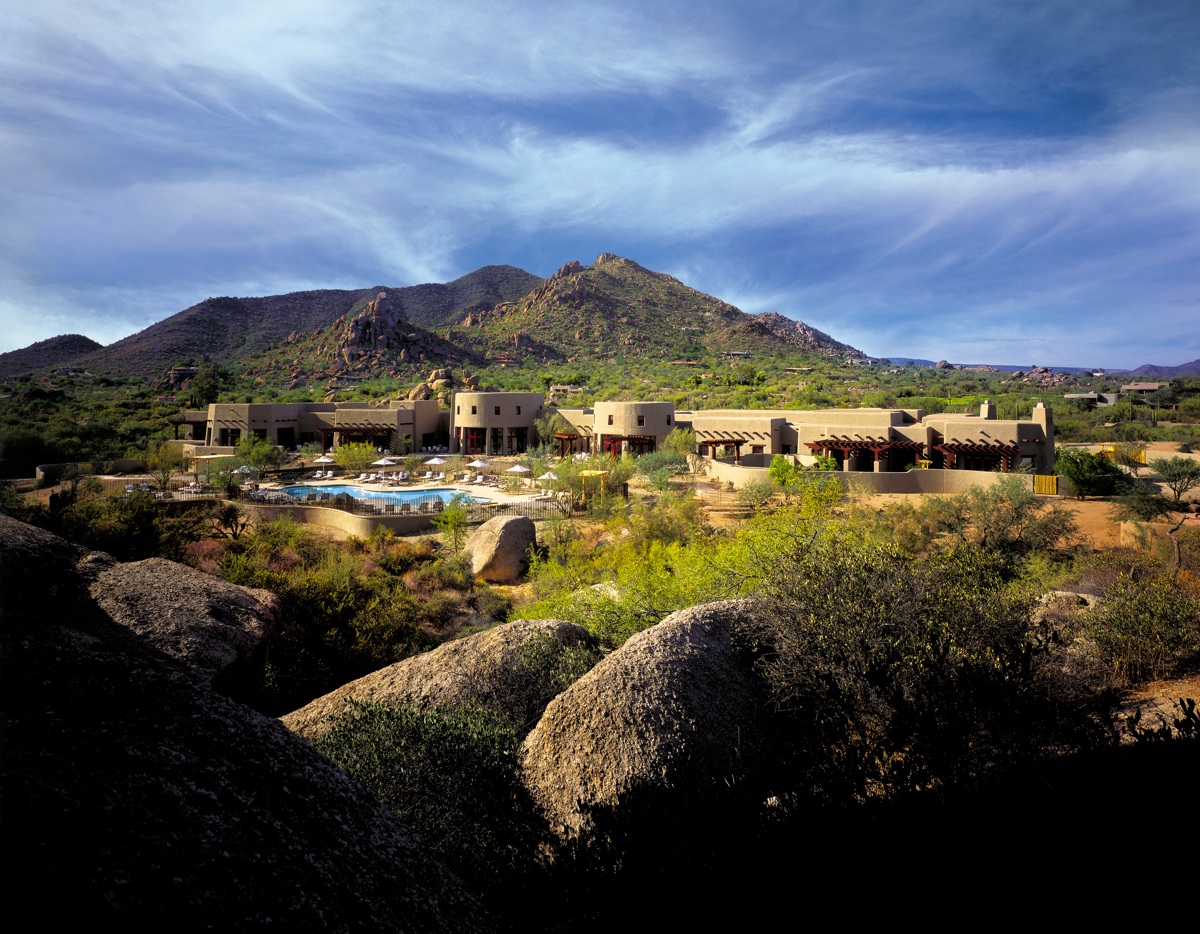
by
Suzanne Wright
It’s just after 9 p.m. I’ve just finished a very satisfying dinner in the Latilla restaurant (below) at The Boulders: creamy corn chowder; blackberry and pistachio salad with goat's cheese; flat iron steak with pasilla jus and a huckleberry emulsion, roasted Brussels sprouts and patty pan squash; and strawberry shortcake washed down with an icy, wine-kissed margarita.
In
September,
the
air
is
still
scorching
by
day,
climbing
over
100
degrees.
But
at
night
it
softens as a
blanket of black covers the sky, punctuated only by scattering of stars
and a half moon. And though a golf cart is always at the ready to
whisk guests
back to their casita, I’d rather walk. Just to the left of the
entrance, I see
four staffers gathered. I advance slowly, then I see
it: a
western diamond back rattlesnake curled on the dirt.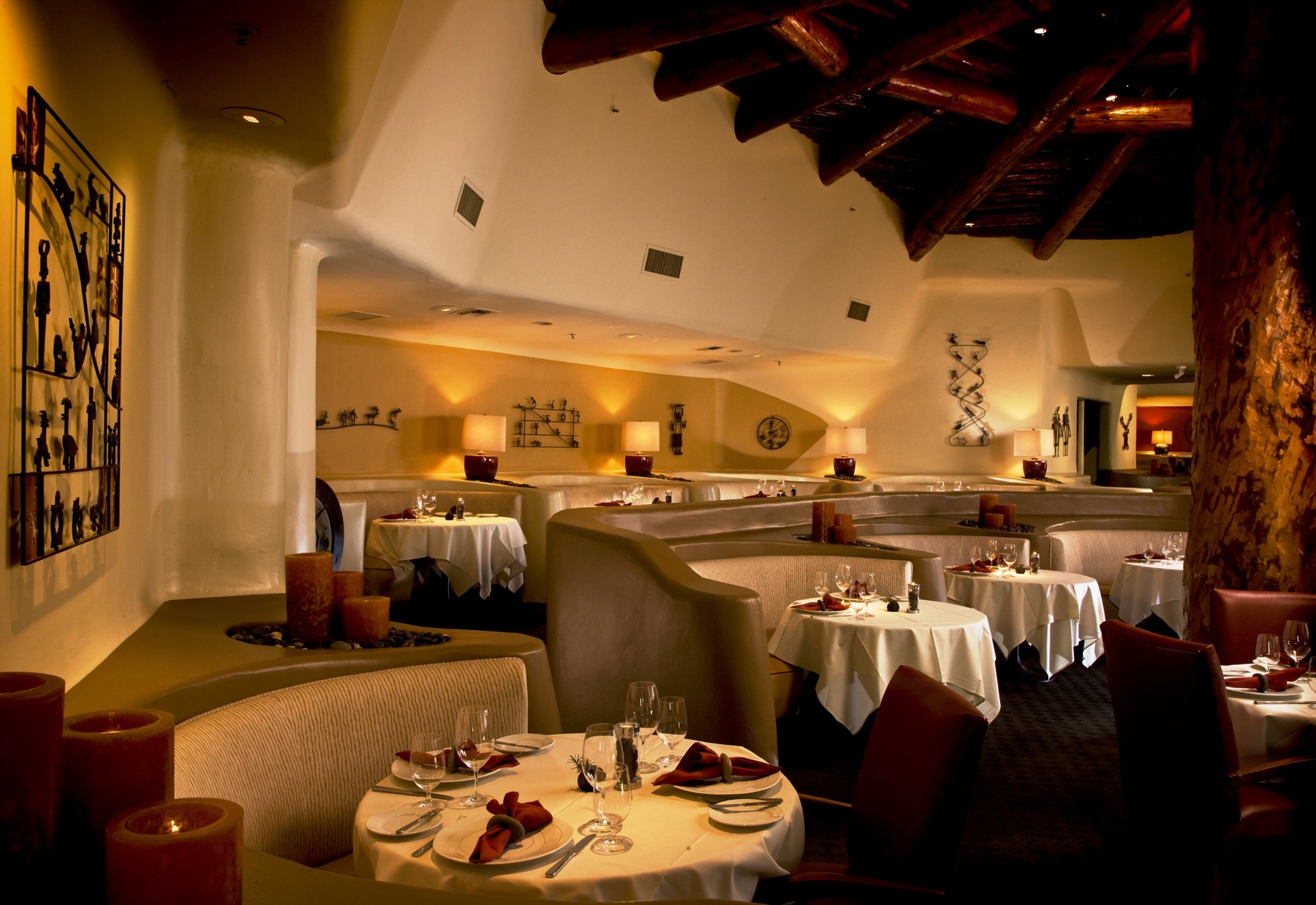
The snake is magnificent; apparently not agitated, silent. Still, says one staffer, he sometimes makes a “big noise.” Another staffer estimates him at three-and-a-half feet in length. He says I am lucky to see a rattlesnake, they’ve been scarce this summer.
I look down, smiling to myself: I’m wearing a snakeskin-printed blouse. Have I sartorially summoned the snake with my choice of clothing? I am secretly thrilled.
“Snakes are misunderstood.” I say. “They are transformative, a good omen.”
There’s a division of opinion on this. An employee has been radioed to wrangle the snake into a pail. It will be released nearer to the mountain, further from the resort’s skittish guests.
“Would you like to feel how heavy he is?” he says, thrusting the pail to me. My heart quickens as I reach for it. It is surprisingly heavy. Minutes later, I head down the illuminated path to my casita. I don’t see any more snakes, just the majestic silhouette of the saguaro cactuses in the moonlight. For all its low-key elegance, The Boulders is still a wild place, the habitat of desert creatures.
Twenty years ago, I first visited this celebrated resort, a favorite hideaway of celebrities and power brokers. Its impact was indelible and all these years later my memory of The Boulders remains crystalline. Of course, I was far less traveled then, so I wondered if a return visit would impress me as much.
It does.
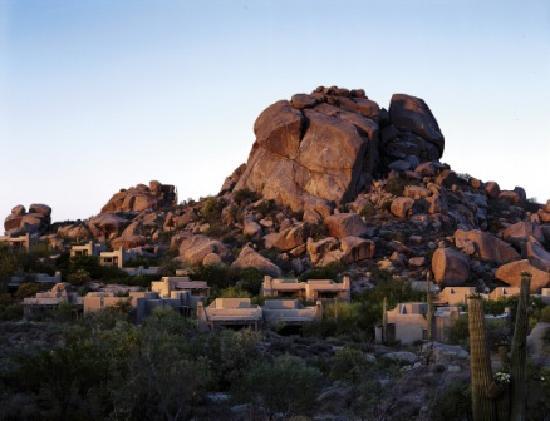 Of
course,
Carefree,
located
45
minutes
north
of
Phoenix,
has
grown
more
populated—and
popular—over
two
decades.
There’s
a
new highway, a
clutch
of restaurants and shops in nearby Cave Creek. But the
stunningly singular
landscape of the Sonoran Desert seems untouched. Unlike so many Arizona
resorts, there’s a real sense of place. It’s the granite boulders
said to
be 12 million years old, the giant saguaros, the
rattlesnakes. I
feel like an extra on a movie set.
Of
course,
Carefree,
located
45
minutes
north
of
Phoenix,
has
grown
more
populated—and
popular—over
two
decades.
There’s
a
new highway, a
clutch
of restaurants and shops in nearby Cave Creek. But the
stunningly singular
landscape of the Sonoran Desert seems untouched. Unlike so many Arizona
resorts, there’s a real sense of place. It’s the granite boulders
said to
be 12 million years old, the giant saguaros, the
rattlesnakes. I
feel like an extra on a movie set.
Simply
put,
The
Boulders
is
iconic.
I’m
an
urban
gal
who
loves
the
wide
open
spaces
of
the
desert. The Boulders boasts 160 casitas and 60 villas
tucked
into the natural terrain. There are the expected top-notch
amenities: two golf courses, six restaurants, a 33,000-square
foot spa,
two swimming pools. My spacious casita has been recently renovated with
a
marble bathroom and cowhide accents. There’s a fireplace and a
wet
bar. But what I like best is the patio’s view of a pile of rocks
as the
sun streaks the sky amethyst and papaya. I like the silence
broken
only by the nasal call of the Gambel’s quail or the hopping of desert
cottontail rabbits. In a wash near my suite, I’m mildly startled
to spy a
pack of javelinas, wild pig-like animals. How incongruous—and how
utterly
fantastic—is it to be headed to a spa appointment and see all this
wildlife! It’s a natural tonic for a city-weary traveler.
The spa complex includes a pool, gift shop, fitness center and 24 treatment rooms; in addition, there’s a meditation labyrinth and an organic garden. And everywhere, boulders dominate the view, sharing it with tree-sized, armed saguaros. Frankly, it’s too surreal to read a book when I’m surrounded by this deeply unusual landscape. I simply surrender into it, floating in the pool, stealing glances of those looming rocks.
It takes something special to rouse me at the ungodly hour of 5 a.m.; a hot air balloon ride qualifies. After we tumble out of the van, we watch as the balloons are inflated. When fully inflated a balloon is more than seven stories tall; the fabric weighs over 700 pounds.
Twelve of us climb into the basket, giddy with excitement. The sun is up and soon we lift off, hot blasts of air keeping us afloat. From 5,000 feet, we have the proverbial bird’s eye view, gliding over saguaro and washes, even the interstate at rush hour. Back on the ground, après ballooning, the crew lays out a breakfast spread of quiche and pastries from acclaimed Phoenix chef Vincent Guérithault. We toast with mimosas as Captain Mike passes out our certificates and points out the circling coyotes that await the leftovers.
From my base
at the Boulders, there’s plenty to explore north of Phoenix. Frank
Lloyd
Wright’s Taliesin West (below) has been called a “man made
desert
masterpiece” for the way it blends and blurs the line
between
indoor and outdoor spaces. 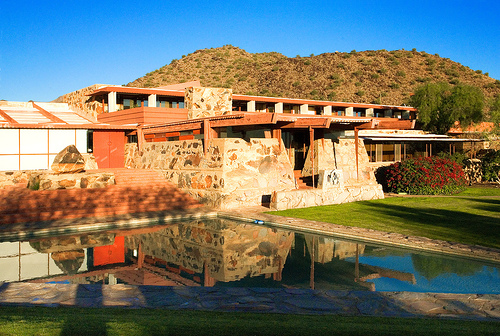 Wright first came to Arizona in 1927 and by 1937,
at the age of 70, had established his winter residence in the foothills
of
the McDowell Mountains, his so-called organic architecture is
integrated into the surroundings. (Perhaps the Boulders’ architects
took
their cue from Wright). There’s an interesting tension
between the
expansive, light feeling in the desert and the low, dark
interiors. During
the 90-minute Insights Tour, I learn about the cantilevered roof, the
hexagonal
doors, the desert masonry and the “compress and release” sensibility
that make
this residence unique. This National Historic Landmark still serves as
a vibrant center for a community of architecture students, artists and
teachers.
Wright first came to Arizona in 1927 and by 1937,
at the age of 70, had established his winter residence in the foothills
of
the McDowell Mountains, his so-called organic architecture is
integrated into the surroundings. (Perhaps the Boulders’ architects
took
their cue from Wright). There’s an interesting tension
between the
expansive, light feeling in the desert and the low, dark
interiors. During
the 90-minute Insights Tour, I learn about the cantilevered roof, the
hexagonal
doors, the desert masonry and the “compress and release” sensibility
that make
this residence unique. This National Historic Landmark still serves as
a vibrant center for a community of architecture students, artists and
teachers.
After touring Taliesin in the heat of the day, lunch at The Greene House at Kierland Commons (a shopper’s paradise) offers California-inspired cuisine in cool, chic surroundings. The herb hummus is bursting with flavor, thanks to the chopped tomatoes, raw onion and feta; I lap it up with thick grilled pita bread. Two creative pasta dishes floor me: fresh pea dumplings stuffed with bok choy and enoki mushrooms dunked into a sweet chili broth, and corn cannelloni with baby tomatoes and a basil salad. Grilled baby artichokes brushed with parmesan and lapped with balsamic vinegar round out a fine meal. A basil gimlet is a fine herbaceous liquid accompaniment.
The
Heard
Museum North Scottsdale is an outpost of the renowned
downtown museum, featuring
two exhibition galleries, a café and a terrific gift shop.
In addition to
eating, Scottsdale is known for great shopping. Though too much
of the
space is empty (recession woes), El Pedregal, near The Boulders,
offers a
couple of notable boutiques: Conrad’s
for beautifully handcrafted handbags and
interesting jewelry. In the same shopping center is The Spotted Donkey (right),
where the nachos are stacked with pulled pork, roasted tomatillo salsa
and
Mexican crema; the
mac-and-cheese is spiked with chiles and applewood smoked
bacon.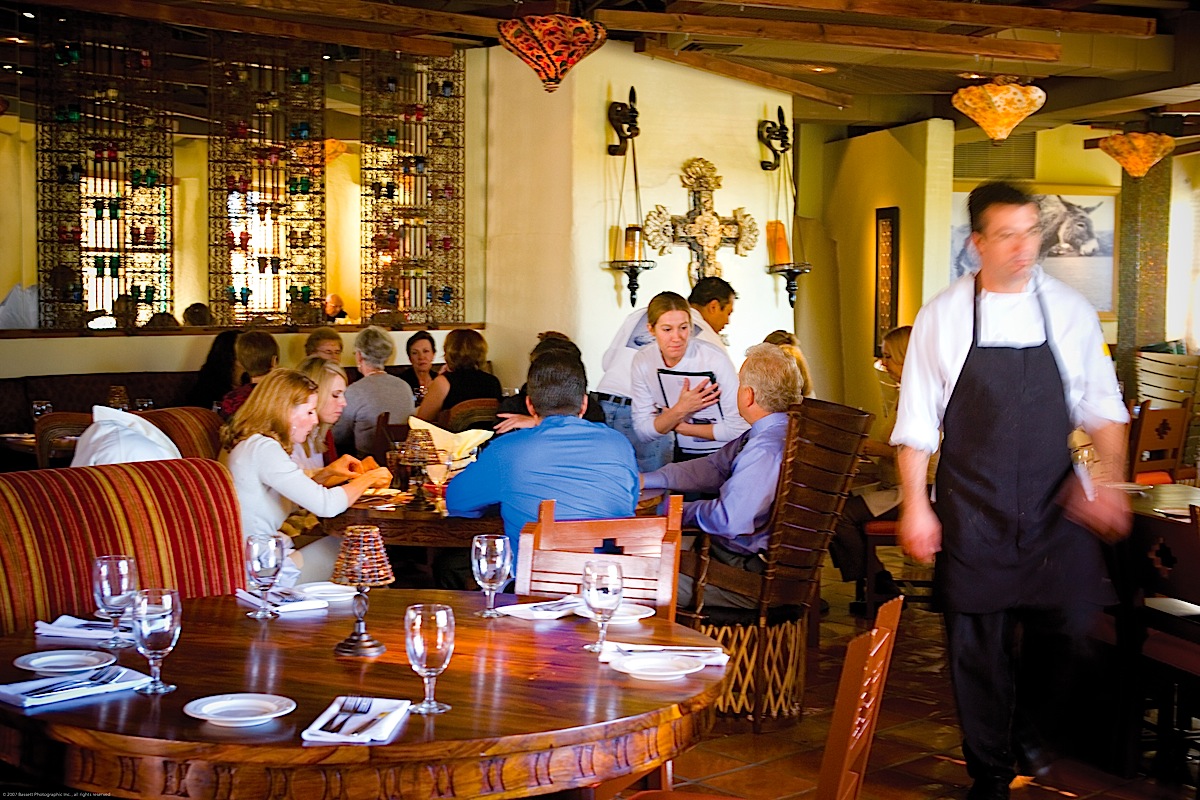
After the day’s exertions, some spa time is in order. I mindfully walk the labyrinth following a dip in the pool, then I’m ready for my 80-minutes massage at the Golden Door Spa. I’m booked for a Thai massage, but I’ve forgotten to wear loose clothes, so Aaron adjusts the session to a combination of deep tissue, cranial-sacral and Swedish with some much-needed stretching. He’s intuitive and offers a plethora of advice about the persistent pain in my sacrum: from walking backward to pressing a lacrosse ball into my back to juicing and drinking grapefruit to lessen inflammation. Tonight, I’ll order room service, but I make a note to breakfast at the spa café for a goat cheese and asparagus omelet and cranberry pecan muffin.
It’s a short walk back to my casita as I step into the glory of the Sonoran desert: a hawk overhead, a javelina, rabbits, the quail, the saguaro, prickly pear, those marvelous boulders. I pour myself a glass of wine, open the balcony door and take it all in.
~~~~~~~~~~~~~~~~~~
NEW YORK CORNER
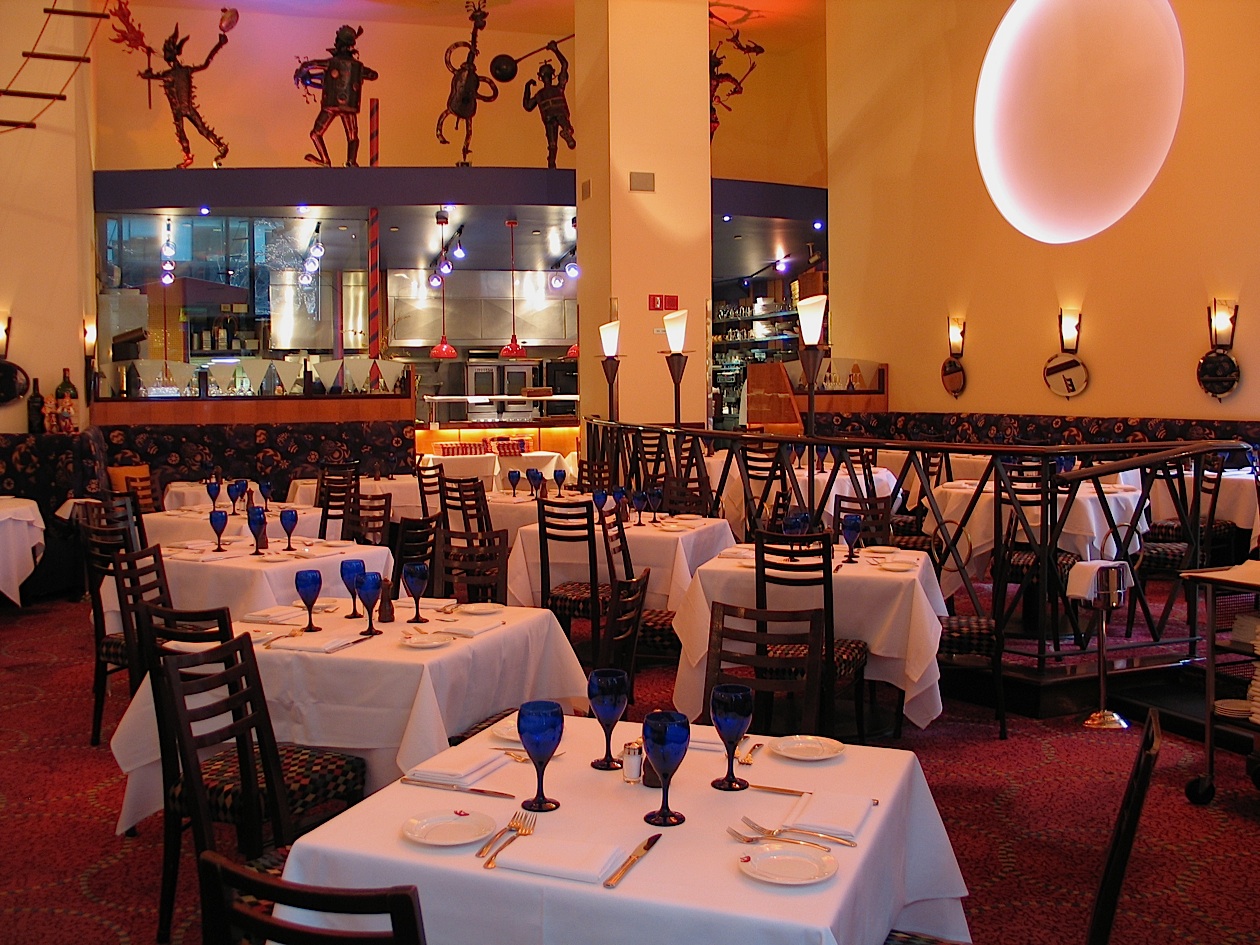 OSTERIA DEL CIRCO
OSTERIA DEL CIRCO
120 West 55th Street
212-265-3636
osteriadelcirco.com
Osteria
del
Circo
has
been
one
of the West Side's best Italian restaurants for
a decade now, always under the ownership of the Maccioni family that
also owns Le Cirque (with branches of both restaurants in Las Vegas),
and for most of those years the refined maitre d' Bruno Dessai. Adam
Tihany's design still evokes the gaiety of dining under a circus
tent, and Egidiana Maccioni still makes sure everything of the menu is
of top quality.
There's a new chef onboard, so it seemed good
reason to return to this ebullient, very colorful ristorante. Michael Galata (below), a 30-year old Jersey boy,
grew up in his family's restaurant and followed his culinary star,
joining Le Cirque 2000 to rise to sous-chef there, now chef de cuisine
at Circo. As with previous chefs at the restaurant, the signature
dishes are still on the menu--God forbid they should think of taking
them off!--to which Galata has added his own ideas.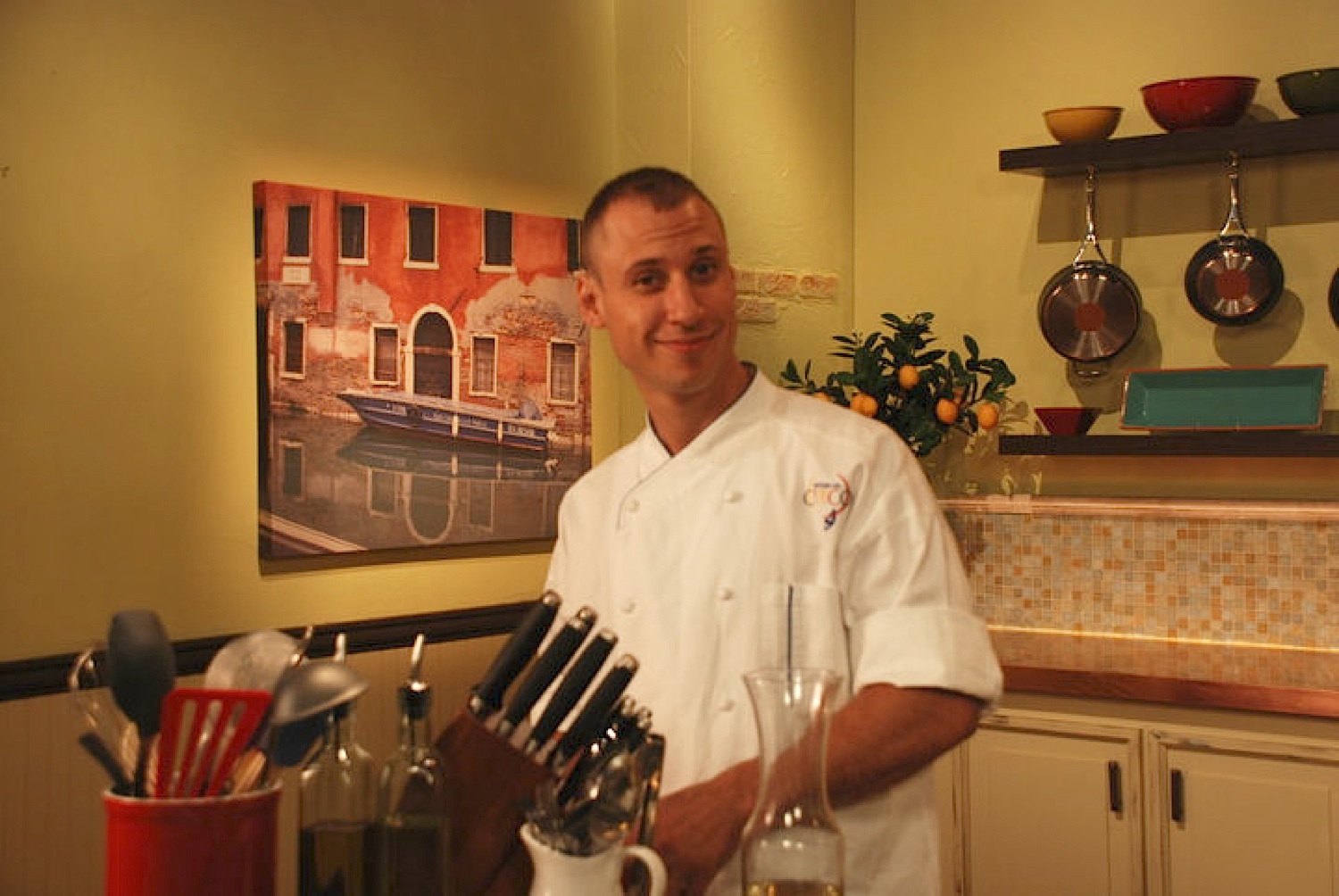
The thrust of the menu is Tuscan (whence
originated the Maccionis), so you can begin with a generous Antipasto
Toscano "Del Circo," a platter of mixed salumi, crostini with chicken liver
puree, pecorino cheese, and marinated vegetables. There is sushi-grade
tuna sliced and served with bottarga
roe and a spiced oil to bring the flavors into focus, capers and orange
for tang. Zuppa alla Frantoiana is an old favorite here, a
"thirty vegetable and bean soup" ideal for the cool weather now
drifting into New York. The thin pizzas here are excellent, one big
enough for the table to share.
You cannot go wrong with any of
the pastas, housemade, of course, from Egi's ravioli di Mamma stuffed with
buffalo ricotta and spinach, simply dressed with butter and sage. The
straightforward spaghetti alla
chitarra with tomatoes and basil is as bright and savory as any
in town, the the pappardelle with duck ragù and porcini is a triumph of autumnal
Tuscan flavors. (You can have a duo of pastas as a main course
for $29.)
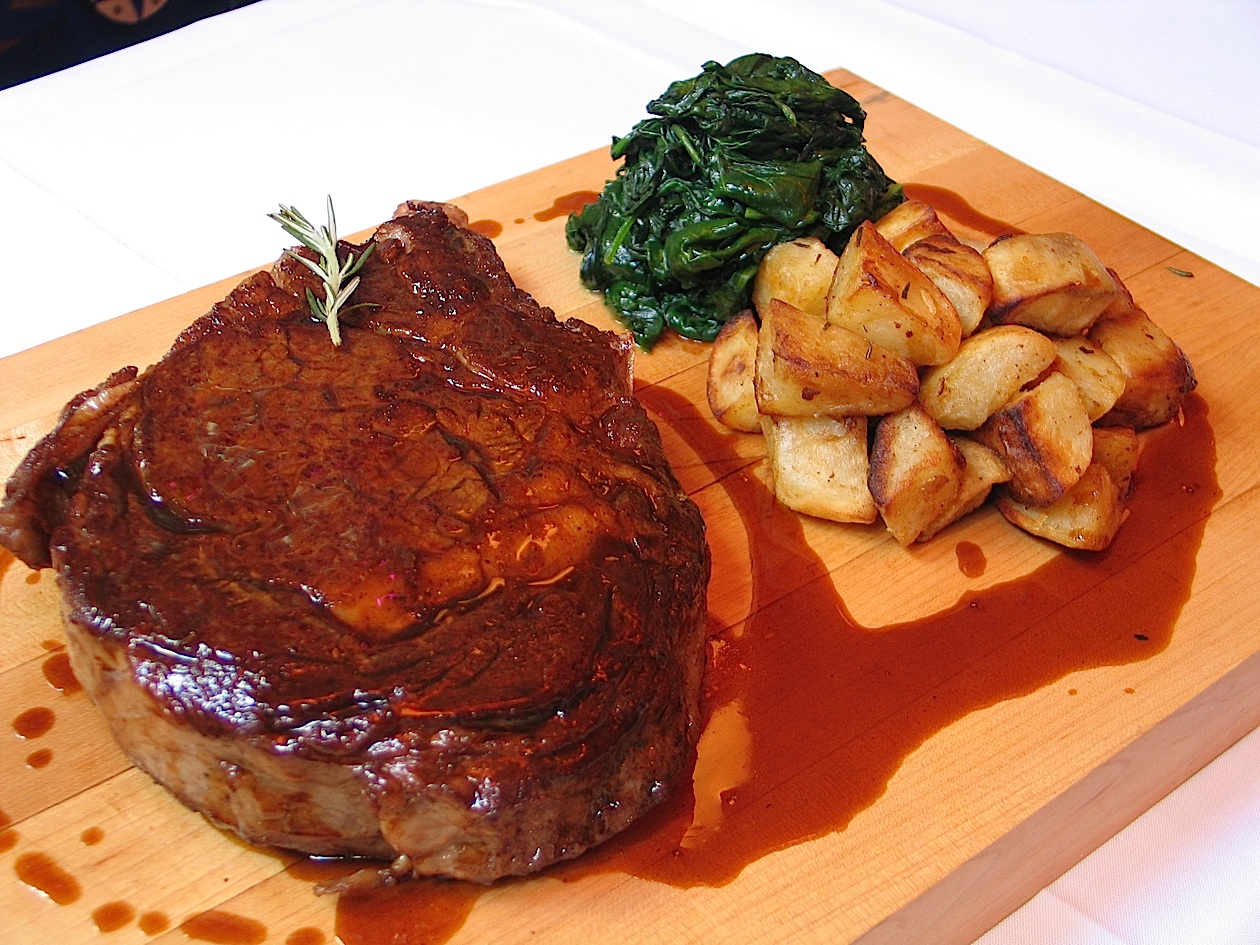 Simplicity is the key to Tuscan
cooking and it is the style of most of the main courses, including
wonderful scallops and shrimp with a parsnip, fennel, mussels, and
bouillabaisse-like reduction. You won't find a better rack of lamb,
Italian style, than Circo's, dusted with pecorino and thyme and served
with chickpeas and roasted red peppers. As you might imagine, the
bistecca alla fiorentina
is a singular rendering here, thick, succulent to the bone, served with
tortellini filled with shortrib meat, charred green onions and broccoli
di rabe--all this for the same price, $45, you'd pay at a steakhouse
for just the meat alone, and you can share this one easily enough, cut
into thick slabs. A Tuscan ribeye, served for two tableside, is
$39 per person (left). There
is also a side of Tuscan fried potatoes you might consider.
Simplicity is the key to Tuscan
cooking and it is the style of most of the main courses, including
wonderful scallops and shrimp with a parsnip, fennel, mussels, and
bouillabaisse-like reduction. You won't find a better rack of lamb,
Italian style, than Circo's, dusted with pecorino and thyme and served
with chickpeas and roasted red peppers. As you might imagine, the
bistecca alla fiorentina
is a singular rendering here, thick, succulent to the bone, served with
tortellini filled with shortrib meat, charred green onions and broccoli
di rabe--all this for the same price, $45, you'd pay at a steakhouse
for just the meat alone, and you can share this one easily enough, cut
into thick slabs. A Tuscan ribeye, served for two tableside, is
$39 per person (left). There
is also a side of Tuscan fried potatoes you might consider.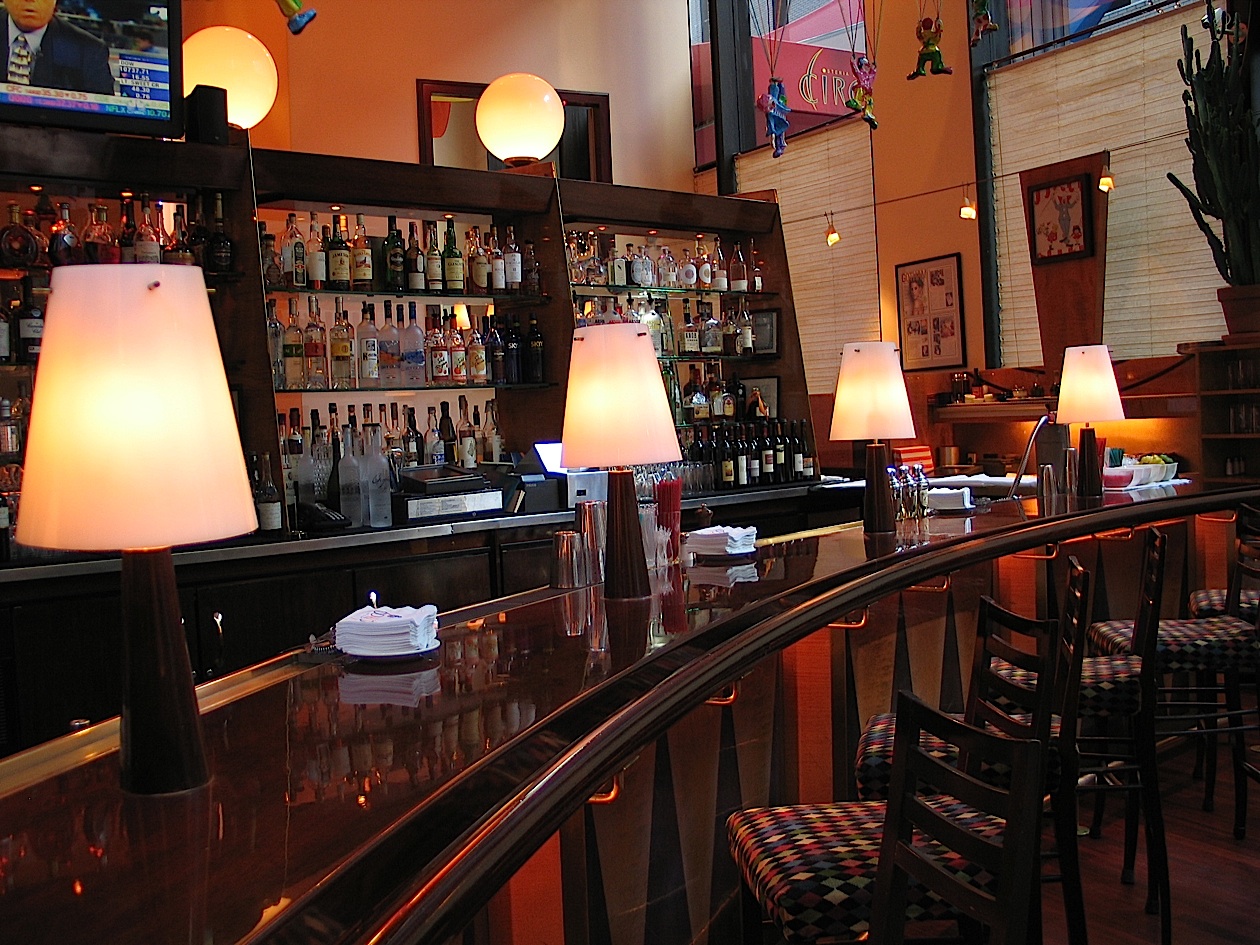
Those who would skip dessert at an Italian
restaurant should not do so at Circo, for just as much care is lavished
on the gelati, panna cotta and
chocolate
desserts
as
on
everything
else on the menu.
Circo is convenient for lunch on the West side,
perfect for pre- and after-theater (it's next to the Ziegfeld
Theater), and always a frothy, happy place for dinner, which may well
include theater people, the fashion crowd, and any star who's in town
this week. The bar (right)
is
a
primo
watering
hole
from five o'clock on and in fair weather the
outdoor tables are much desired. And by the way, the white truffles
have just arrived!
Circo is open Mon.-Fri. for lunch and nightly for dinner. Antipasti run
$11-$19, pastas (as full portions) $24-$29, and main courses
$28-$45. Seven-course
tasting menu $68, with wines $95; Prix fixe $38, from 5 PM-6:30 and
9:30-closing.
~~~~~~~~~~~~~~~~~~~~~~~~~~

MAN ABOUT TOWN
by
Christopher Mariani
The Colors of Colombia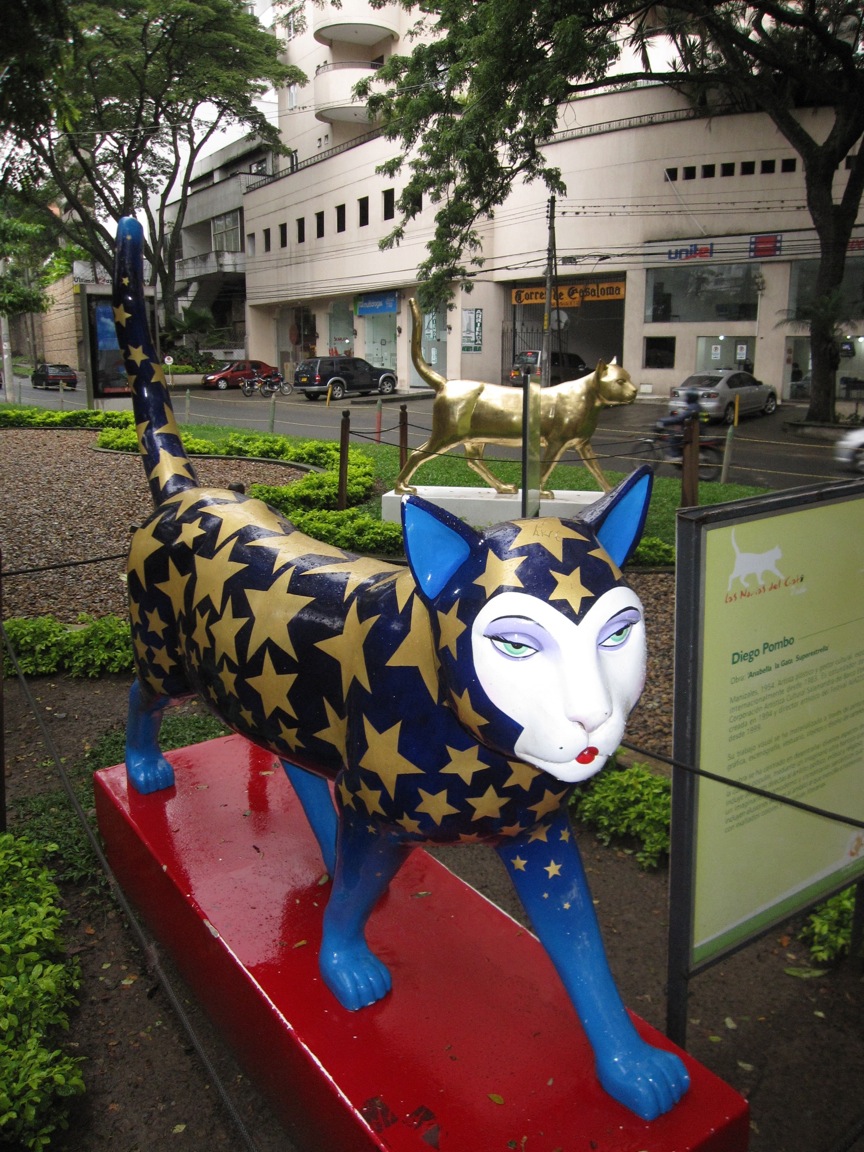
This September I was in Colombia visiting the cities of Cali and Bogotà; both will be reported on in depth in the next month or so.
Whether I was walking
the streets
of Calí or Bogotà,
watching the famous salsa show named Delirio, eating my way through the
open
street
markets, attempting to dance salsa after many shots of aguardiente, or
simply
dining at some of Colombia’s fine restaurants, I witnessed an
explosion
of beautiful, bright colors throughout every inch of both cities. I was told by one Colombian that
colors express emotion and life, and that is why the cities are
blanketed in
color. The Colombians are very
happy people and seem to always find the positive in any situation;
maybe it’s
the beautiful colors that affect their mood, or maybe it’s their
positive
attitudes that create the colors, regardless, the visual effect is
stellar.
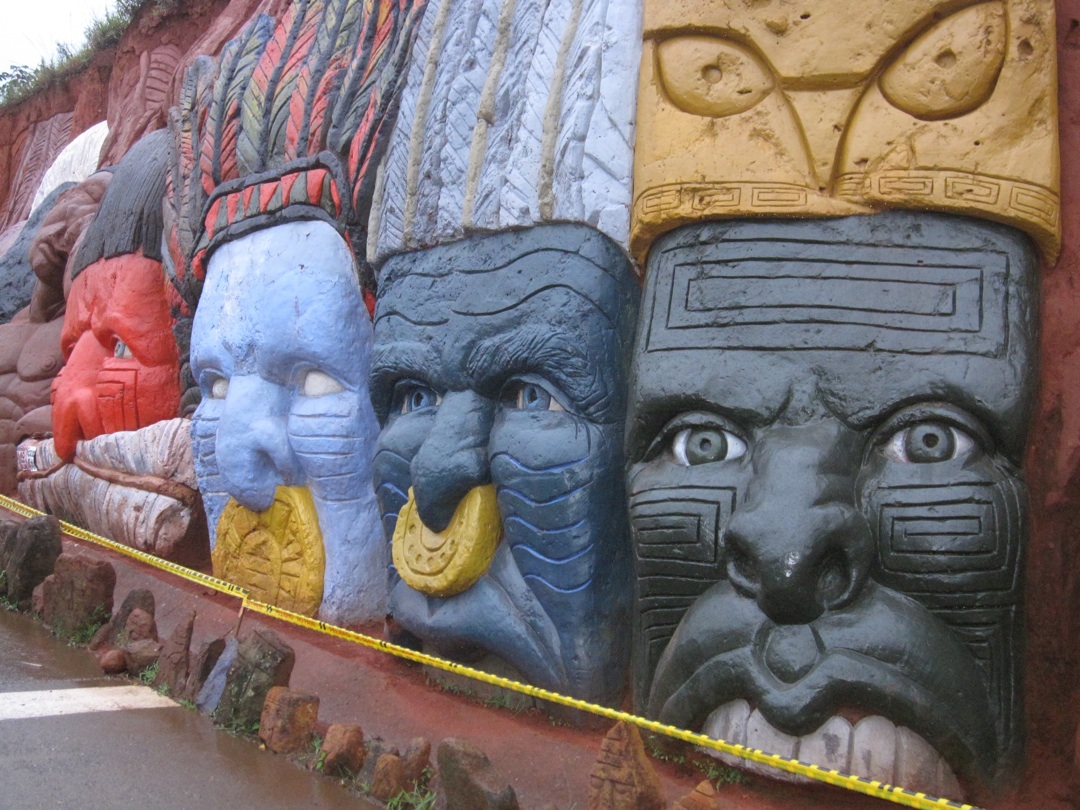 I started in Cali, and
immediately after checking into my
hotel, drove to see the Los
Gatos sculptures near El Peñon along
the Cali River. Many of the cat
sculptures were created
by Colombian artist Hernando Tejada in the
mid-90’s. The first cat of the
collection was named “El Gato del Rio.” My
guide
stated
that
the first cat had become lonely, so Tejada
and other artists began painting more cat sculptures,
to keep
“El Gato del Rio” company. The
sculptures reminded me immediately of NYC’s cow and London’s
elephant collections. One of the
cats is painted almost completely yellow with black ears, striped baby
blue
and white legs, and blue and white eyes. My
favorite
(above) was covered in
multiple shades of blue,
scattered gold
stars, and an all-white face with tiny red lips.
I started in Cali, and
immediately after checking into my
hotel, drove to see the Los
Gatos sculptures near El Peñon along
the Cali River. Many of the cat
sculptures were created
by Colombian artist Hernando Tejada in the
mid-90’s. The first cat of the
collection was named “El Gato del Rio.” My
guide
stated
that
the first cat had become lonely, so Tejada
and other artists began painting more cat sculptures,
to keep
“El Gato del Rio” company. The
sculptures reminded me immediately of NYC’s cow and London’s
elephant collections. One of the
cats is painted almost completely yellow with black ears, striped baby
blue
and white legs, and blue and white eyes. My
favorite
(above) was covered in
multiple shades of blue,
scattered gold
stars, and an all-white face with tiny red lips.
After the cats, along
the
mountainside
of
Cali
where
the
skinny
road
winded
for
turn after turn as we ascended, we 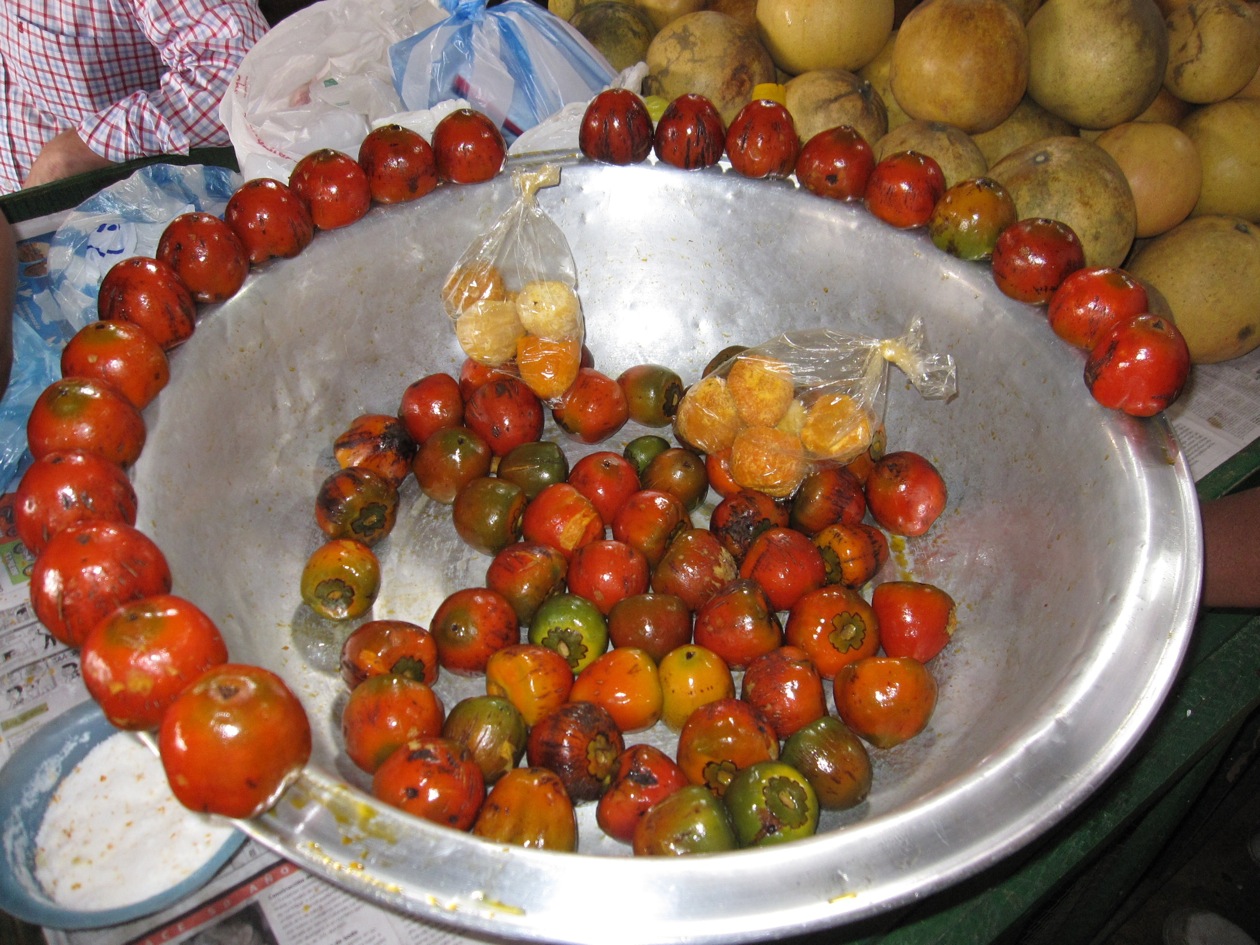 stopped to
take pictures of a
roadside
art exhibition (above)
sculpted by street artist Carlos Andres Gomez. The
pieces
were
sculpted
out
of
the
mud
and
dirt
rising
25 feet above the roadside, then
painted
every
shade of the rainbow. The pieces
range from butterflies to insects to the human body, and my favorite,
the face sculptures, all wearing head pieces.
stopped to
take pictures of a
roadside
art exhibition (above)
sculpted by street artist Carlos Andres Gomez. The
pieces
were
sculpted
out
of
the
mud
and
dirt
rising
25 feet above the roadside, then
painted
every
shade of the rainbow. The pieces
range from butterflies to insects to the human body, and my favorite,
the face sculptures, all wearing head pieces.
For
lunch that afternoon I dined at a restaurant called Ringlete, that
served very
traditional Colombia
food specific to the city of Cali. The
outside of the restaurant was covered from the base of
the building
to the roof in a bright pink with white lettering.
The walls of the interior were covered with oil paintings
containing intense shades of tangerine orange, lime green, and deep
blue. The tablecloths are the color of a
fresh watermelon and the trim of the rooms were a key lime green, not
to
mention each table was decorated with small vases filled with flowers,
a nice
classy touch. The lunch itself consisted
of many colorful items like bright yellow plantains, green hot sauce
and
red
onion.
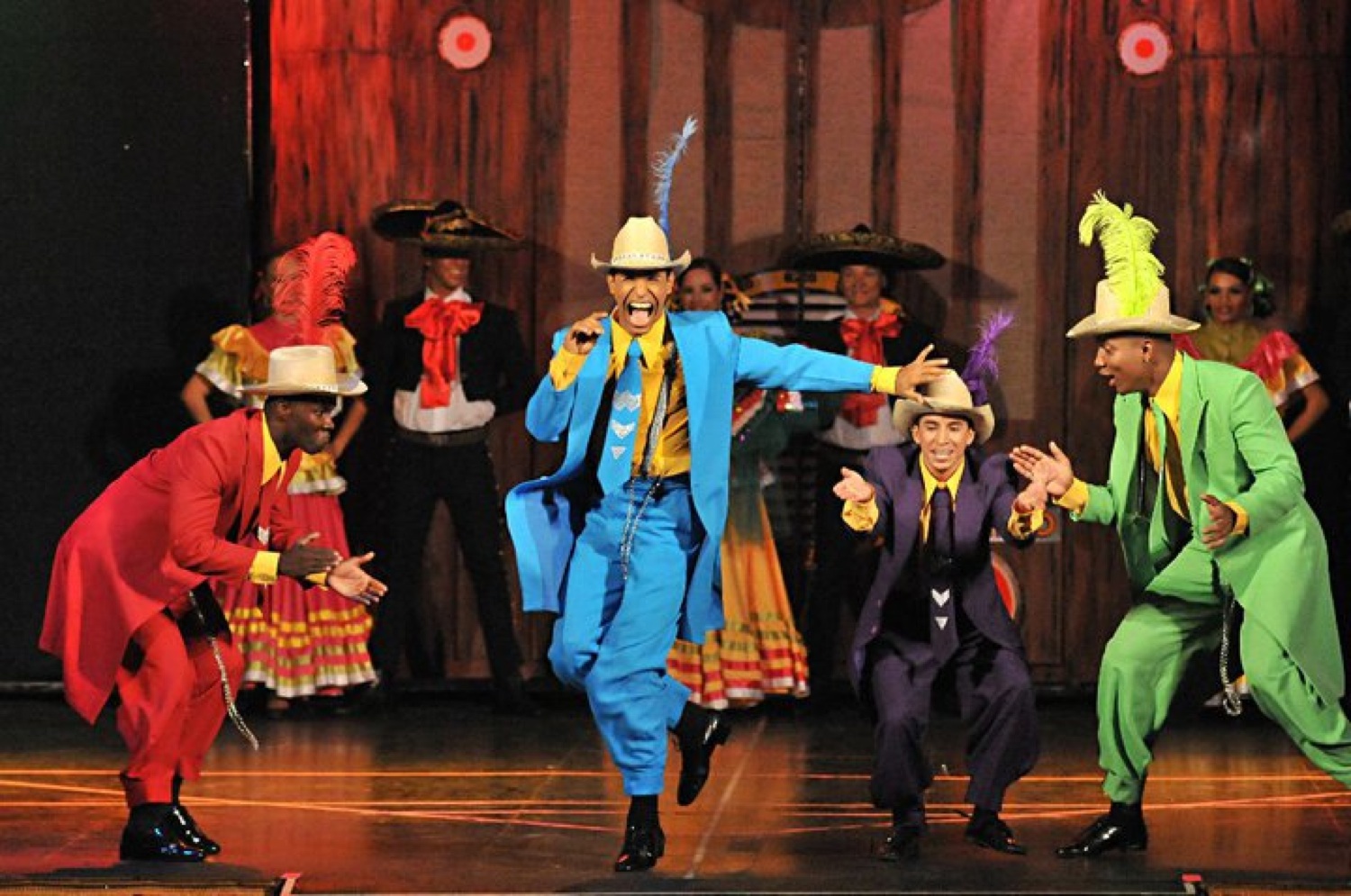 The following day, I
visited the
Plaza De Mercado Alameda
street market. Inside there were
entire sections of beautiful flower stands, entire rooms dedicated to
colorful
produce (above), cooked meat
stations and butchers where entire racks of ribs
hung from
giant meat hooks. There were
amazing pork sausages and cured meats that filled glass cases, endless
rows of
fruit and vegetables found in every color, and tiny empanadas
filled with potatoes, pulled pork, and salty beef, all sided
by spicy green dipping sauces made with chopped raw onions and
cilantro. The peppers and tomatoes
were deep
shades of red that made American supermarket items look like rubbish. It was also the constant aroma of sweetness
from the fruit, spice from the dried peppers, smokiness from the cured
meats,
oil form the empanadas, and
Colombian coffee permeating the
café sections
that made the experience so
The following day, I
visited the
Plaza De Mercado Alameda
street market. Inside there were
entire sections of beautiful flower stands, entire rooms dedicated to
colorful
produce (above), cooked meat
stations and butchers where entire racks of ribs
hung from
giant meat hooks. There were
amazing pork sausages and cured meats that filled glass cases, endless
rows of
fruit and vegetables found in every color, and tiny empanadas
filled with potatoes, pulled pork, and salty beef, all sided
by spicy green dipping sauces made with chopped raw onions and
cilantro. The peppers and tomatoes
were deep
shades of red that made American supermarket items look like rubbish. It was also the constant aroma of sweetness
from the fruit, spice from the dried peppers, smokiness from the cured
meats,
oil form the empanadas, and
Colombian coffee permeating the
café sections
that made the experience so 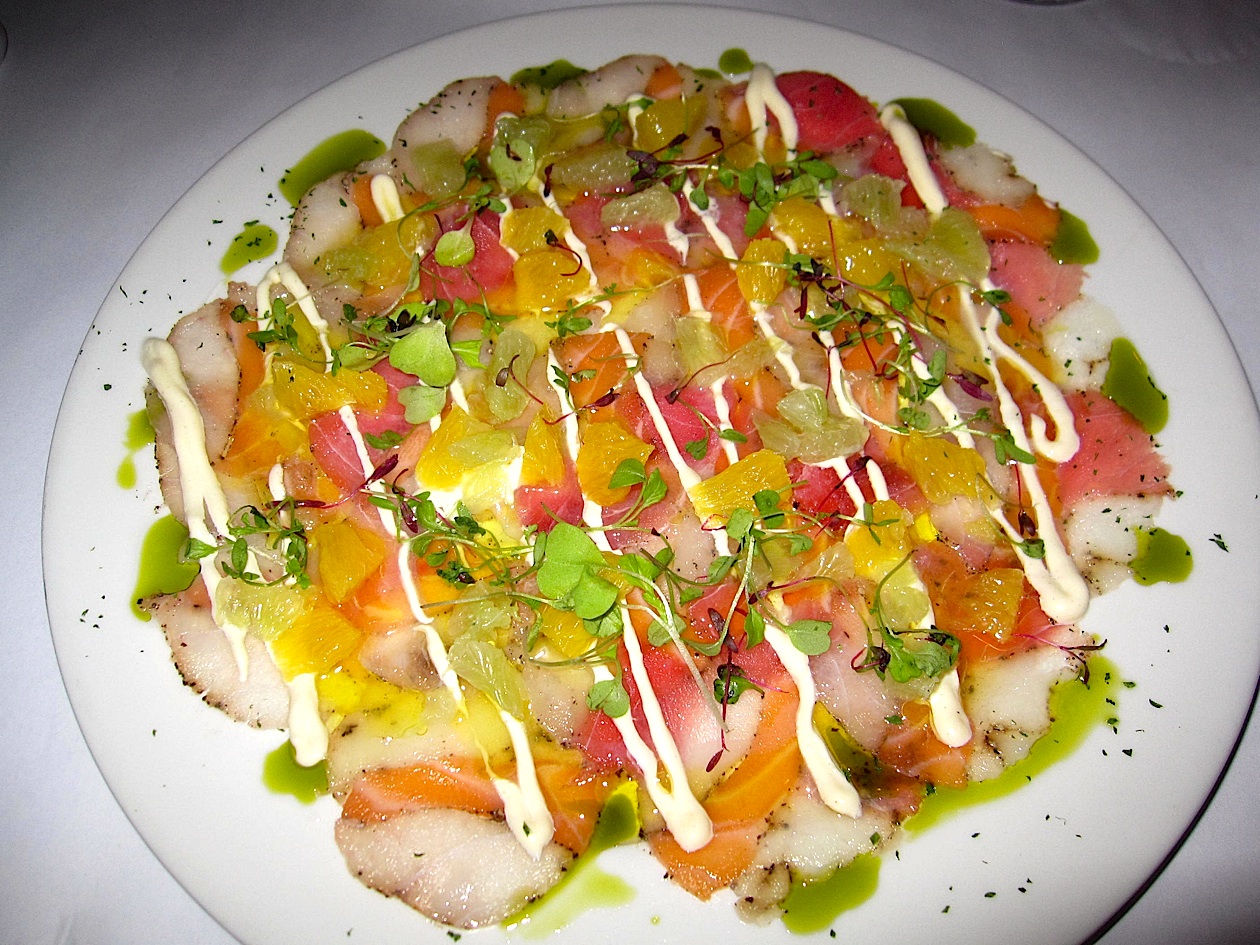 wonderful.
wonderful.
That evening at the Delirio
salsa show (above), performed
monthly, I
sat back at a long table as I ate empanadas,
chicharrons (deep
fried
squares
of
pork belly), and drank shot after
shot of aguardiente as I
watched in awe because the salsa dancer’s feet
seemed never to touch
the ground while they performed traditional salsa underneath a
giant red
and yellow circus tent. The night
was so vibrant and the imagery spectacular, not to mention how
gorgeous the Colombian female dancers were. Even
the
servers
and
drink
girls
were
amongst
the
most
stunning beauties I have ever seen; I need to go
back to
Colombia.
The following day I was on
a flight off
to Bogotà ,
where I dined at one of Harry Sasson’s restaurants, Harry Sasson,
and was immediately
brought a
colorful plate of ceviche (above,
right),
so
pretty I almost felt guilty cutting
through its
culinary design with my 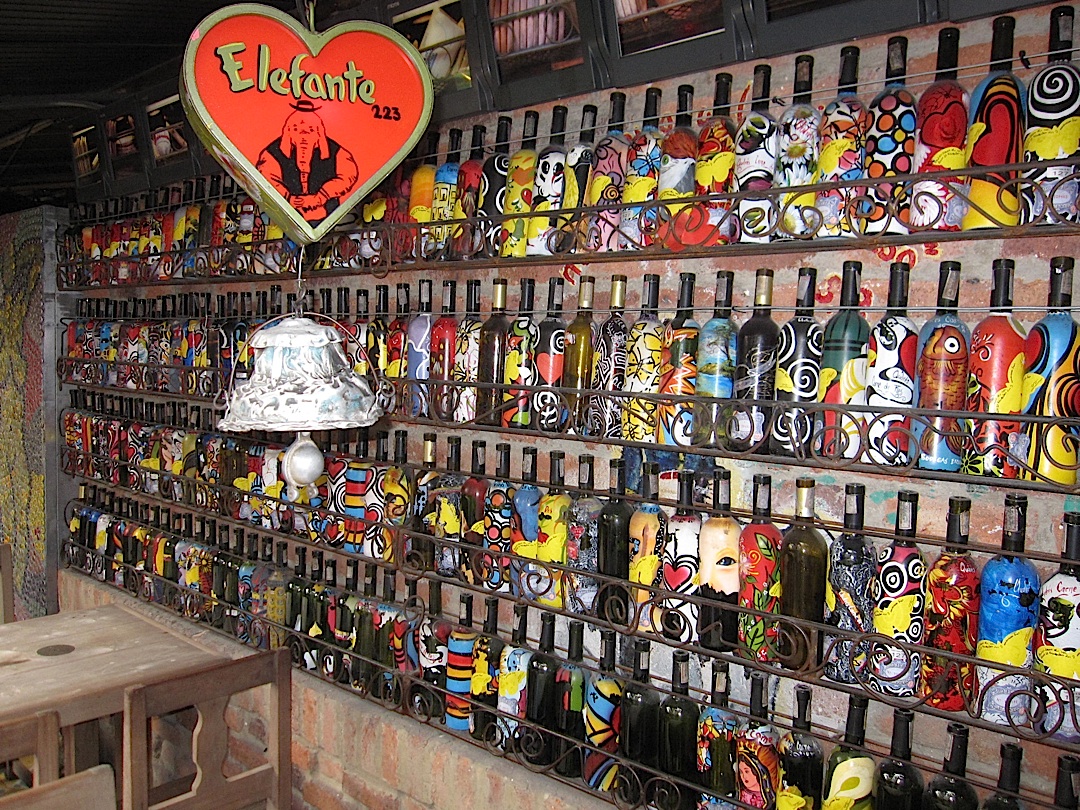 knife. The
next day at Andres
Carne
de
Res located
just outside of Bogotà, I entered what appeared to be a museum
of craft
art. The entire restaurant was
filled with wood furniture and densely decorated with little pieces of
colorful
art work,
painted bottles (left), bright
ornaments, shiny signs, and red heart -shaped
lanterns
individually named above each table. I
could go on and on about the multitude of colors in
Colombia, but I
must save some of this for my piece on Colombia that will be featured
in the
near future.
knife. The
next day at Andres
Carne
de
Res located
just outside of Bogotà, I entered what appeared to be a museum
of craft
art. The entire restaurant was
filled with wood furniture and densely decorated with little pieces of
colorful
art work,
painted bottles (left), bright
ornaments, shiny signs, and red heart -shaped
lanterns
individually named above each table. I
could go on and on about the multitude of colors in
Colombia, but I
must save some of this for my piece on Colombia that will be featured
in the
near future.
To contact Christopher Mariani send an email to christopher@johnmariani.com
~~~~~~~~~~~~~~~~~~~~~~~~~~~~~~~~~~~~~~~~~~~~~~~
NOTES FROM THE WINE CELLAR
SHERRY, BABY!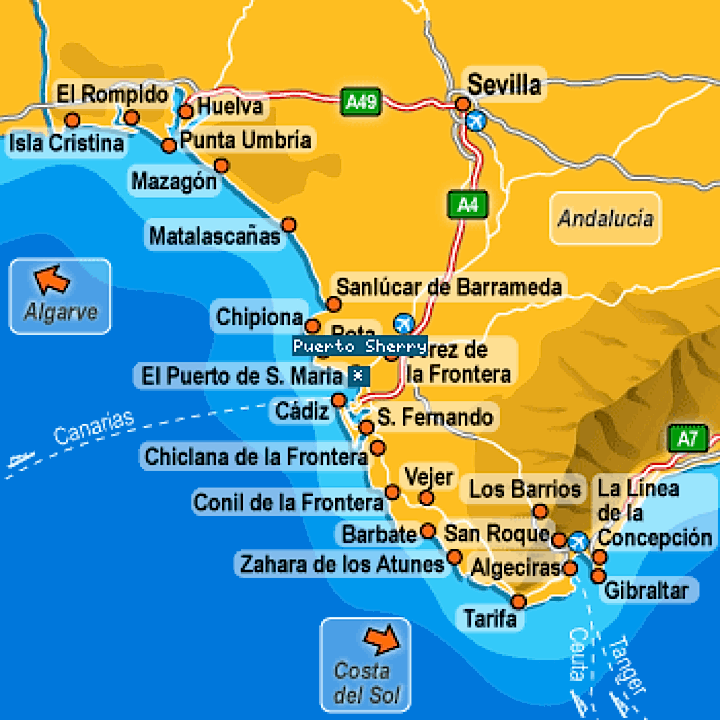
by Brian Freedman
I recently returned from an exceptionally eye-opening trip to Jerez, Spain, and throughout the five days I spent exploring the Sherry-producing districts, one thought kept on creeping into my mind: I cannot believe I never drank more of this wine before. This was one of those paradigm-shifting trips that not only opened me up to Sherry in particular, but that also forced me to reconsider what I thought fermented grape juice was capable of.
No matter where they’re from, the best wines are firmly rooted to a specific geographical location. And, indeed, the standard classifications and appellations of Europe are based on the idea that the same grape variety can be harvested from two neighboring villages, for example, yet the resulting wines will express themselves in completely different ways as a result of the changes in the geology of the vineyards and the micro-climatic shifts from one place to the other.
In Jerez, however, things are a bit different, while still inextricably tied to this particular place. Travel to Bordeaux or Burgundy, by way of contrast, and you’ll hear the constant drumbeat of the importance of the land; great wines, they tend to say, are made in the vineyard. In Jerez, however, we were told time and again that the best wines, while certainly requiring good fruit and vineyard sites, are generally made in the winery and over the years in the barrels as they age and evolve.
 Unlike
standard dry wine, most of which is sold year after years in
vintage-designated
bottlings, Sherry is the result of the region’s famous solera
system (left). Put simply, the
solera
system facilitates the progressive blending of new wines and older
ones, which
layers the flavors and aromas, adds depth and nuance to wines as the
blends
accumulate, and results in a finished product that is as
intimately--and
literally--tied to the past as any wine in the world.
Unlike
standard dry wine, most of which is sold year after years in
vintage-designated
bottlings, Sherry is the result of the region’s famous solera
system (left). Put simply, the
solera
system facilitates the progressive blending of new wines and older
ones, which
layers the flavors and aromas, adds depth and nuance to wines as the
blends
accumulate, and results in a finished product that is as
intimately--and
literally--tied to the past as any wine in the world.
The
success of these fortified wines--the fact that they can be produced at
all, in
fact--is a result of the unique geographical location of the legendary
Sherry
Triangle and the nature of the grapes that grow there, as well as of
the
specific strains of yeast that flourish and the flor
that results. (For specifics on the region, the solera
system, flor, and why real Sherry can only come from
here, visit www.sherrycouncil.com,
the
excellent
web
site
of
the
Sherry
Council
of
America.)
Over the course of my time in Jerez, we had the chance to visit nine bodegas and to taste dozens of samples both on their own and during meals. Perhaps more than anything else, I was flat-out astounded by how well Sherry pairs with food. Some of this success at the table is a result of the range of styles in which Sherry is produced, from dry, supremely refreshing Fino and more caramelized but still lithe Amontillado to rich, structured Olorosos and the dessert-in-a-glass Pedro Ximénez. My favorite style, however, and the overall consensus favorite of the group of six American journalists I traveled with, was the mysterious, relatively rare Palo Cortado, a Sherry that starts out its life as a Fino but whose early-disappearing flor (the protective layer of yeast that prevents a young Sherry from oxidizing) ultimately turns it in the direction of an Amontillado. These wines were consistently among the most expressive, evocative examples we tasted each day.
Yet
perhaps more important to food-friendliness than the range of Sherry
styles is
the nature of the wines themselves, the unexpected ways in which they
frame the
foods they’re being sipped alongside.  For even
though
differences
between, say,
a Fino and an Oloroso are vast, Sherry has the ability to handle a
range of
ingredients that precious few other wines do. Over the course of our
week in
Jerez, we paired various styles of Sherry with everything from sardines
on
tomato bread to garlicky, nutty
baby eels --the famous, and famously expensive, angulas
(right)
to
steak
with mushrooms, foie gras, and even
notoriously wine-unfriendly artichokes. Sherry made easy work of them
all,
highlighting the flavors we wanted, minimizing the ones we didn’t, and
rendering every dish not only more delicious than it otherwise would
have been,
but also a flavor and texture odyssey as enjoyable on an intellectual
level as
it was on a sensory one. The
nature of these wines, and the ways in which their flavor profiles
differ from
the ones most wine writers experience on a more regular basis, force a
reconsideration of the vocabulary employed to describe them.
For even
though
differences
between, say,
a Fino and an Oloroso are vast, Sherry has the ability to handle a
range of
ingredients that precious few other wines do. Over the course of our
week in
Jerez, we paired various styles of Sherry with everything from sardines
on
tomato bread to garlicky, nutty
baby eels --the famous, and famously expensive, angulas
(right)
to
steak
with mushrooms, foie gras, and even
notoriously wine-unfriendly artichokes. Sherry made easy work of them
all,
highlighting the flavors we wanted, minimizing the ones we didn’t, and
rendering every dish not only more delicious than it otherwise would
have been,
but also a flavor and texture odyssey as enjoyable on an intellectual
level as
it was on a sensory one. The
nature of these wines, and the ways in which their flavor profiles
differ from
the ones most wine writers experience on a more regular basis, force a
reconsideration of the vocabulary employed to describe them.
When I travel to a wine region whose wines I’m more or less familiar with, the tasting notes I accumulate over the course of my stay tend to utilize a fairly familiar collection of descriptors. Notes on Champagne lean in the direction of words like toast, brioche, lemon curd, acidity, minerality, and so on. My notes from a visit to Bordeaux last year show words like leather, tobacco, spice, tea, currants, and the like. But this trip to Jerez forced me to change the vocabulary I used to evoke the flavors and aromas I experienced dozens of times a day.
Over the five days of this particular journey, we visited nine bodegas throughout the Sherry Triangle, and from larger ones like Harveys to smaller, more boutique operation like Hidalgo-La Gitana, every visit challenged, instructed, and ultimately charmed me in its own unique way, and introduced me to flavors or textures I hadn’t expected before arriving. (As an aside, Sommelier Aldo Sohm brilliantly paired the Hidalgo-La Gitana Manzanilla with a rich pastrami-cured tuna at a recent, astounding dinner I enjoyed at Le Bernardin. in NYC. The food-friendliness of these wines knows no bounds.)
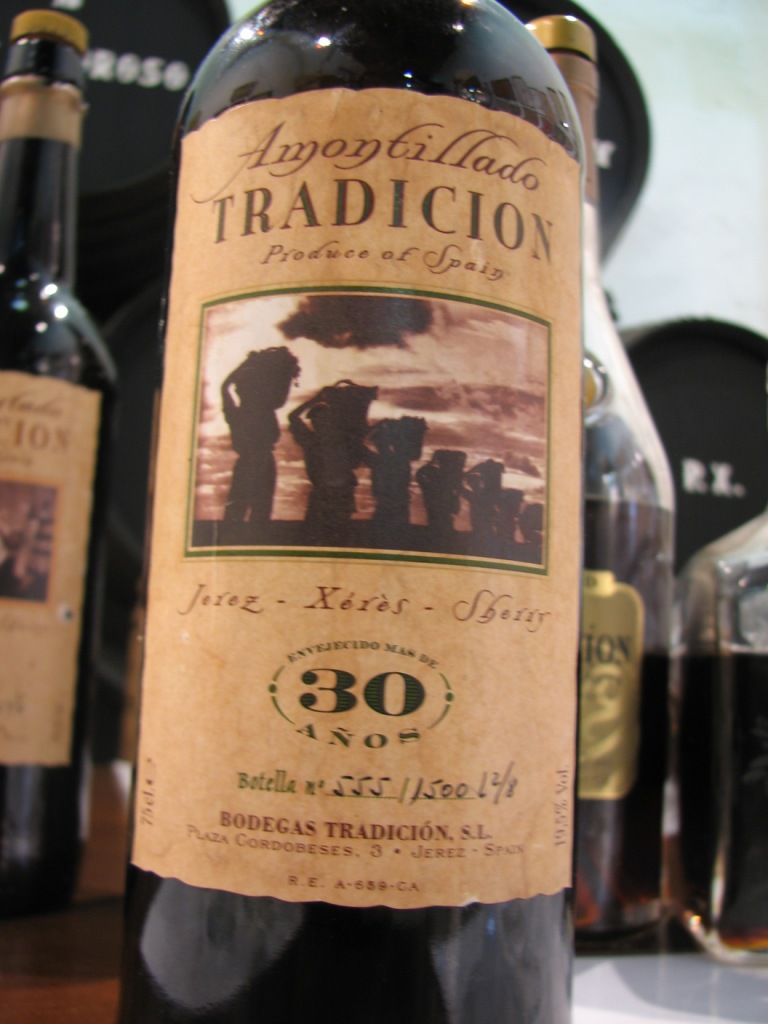 The Harveys Amontillado
VORS,
for example, a Sherry whose average age is more than
70 years old and whose solera system
was started way back in 1914, forced me to make comparisons to
everything from
cardamom and turmeric to dry honey and peanut skin. Bodegas Tradición’s Pedro
Ximénez reminded me of a humidor filled with Cuban
Montecristo cigars. La Guita
Manzanilla smelled of apples, briny ocean air, and soy sauce. Sánchez Romate’s
Moscatel Ambrosia evoked garam masala and blueberry compote. A
barrel sample of Hidalgo-La Gitana’s
Palo Cortado
started off with a hint of salty caramel and
ended on an unexpected flutter of fennel pollen.
The Harveys Amontillado
VORS,
for example, a Sherry whose average age is more than
70 years old and whose solera system
was started way back in 1914, forced me to make comparisons to
everything from
cardamom and turmeric to dry honey and peanut skin. Bodegas Tradición’s Pedro
Ximénez reminded me of a humidor filled with Cuban
Montecristo cigars. La Guita
Manzanilla smelled of apples, briny ocean air, and soy sauce. Sánchez Romate’s
Moscatel Ambrosia evoked garam masala and blueberry compote. A
barrel sample of Hidalgo-La Gitana’s
Palo Cortado
started off with a hint of salty caramel and
ended on an unexpected flutter of fennel pollen.
This intellectual and linguistic stretching, it seems to me, is both the definition of a successful in situ wine education and one of the great underlying justifications and benefits of travel, regardless of its stated purpose.
Regarding
this particular trip, however, there was one lesson learned above all
others:
Though Sherry is not yet as widely consumed on this side of the
Atlantic as its
unfortified cousins, more and more of it is being imported, added to
wine
lists, and used in cocktails, and seeking it out and stocking your
cellar with
a broad enough range of styles and producers to start the process of
learning
more about it will not only put you firmly ahead of the curve, but will
prove
to be one of the most interesting, delicious voyages of discovery you
can take.
Brian Freedman is a food, wine, and travel writer, wine consultant, and speaker. He writes the blog UncorkLife.com for Wine Chateau, is restaurant critic for Philadelphia Weekly, South Jersey Magazine, and Suburban Life Magazine, wine columnist for Affluent Magazine, and contributes to a number of other publications, including Philadelphia Style Magazine.
```````````````````````````````````````````
LI SO LUCKY!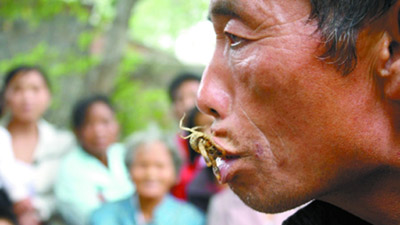
A
Chinese man named Li Liuqun, 58, says he has become
addicted to eating live scorpions and has gulped down at least 10,000
over the last 30 years. Liuqun recalls getting addicted to the
bugs when he was stung by a huge scorpion. "I was so angry I picked it
up
and bit its head off. It tasted sweet and nutty and I never looked
back.," he says. "To me,
they're delicious - like fried beans. I still get stung but they have
no effect on me."
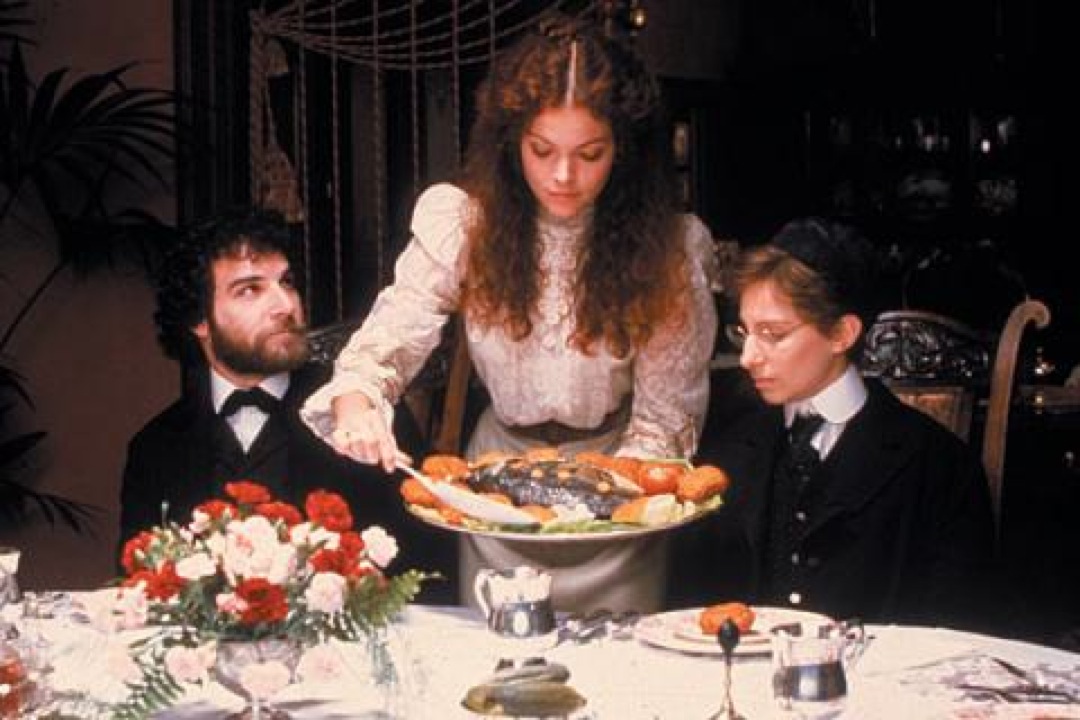 . . .
AND
THEIR
SCHMALTZ FROM THEIR SCHMUCK!
. . .
AND
THEIR
SCHMALTZ FROM THEIR SCHMUCK!"I'm all for giving the undereducated, over-Budweisered campus crowd a chance to learn their Tucher from their tuchus."--Craig LaBan, "City Tap House," Philadelphia Inquirer.
`````````````````
QUICK BYTES
✉ Guidelines for submissions: QUICK BYTES publishes only events, special dinners, etc, open to the public, not restaurant openings or personnel changes. When submitting please send the most pertinent info, incl. tel # and site, in one short paragraph as simple e-mail text, WITH DATE LISTED FIRST, as below. Thanks. John Mariani
NOTE WELL: OWING TO THE NUMBER OF THANKSGIVING-RELATED EVENT ITEMS SUBMITTED TO THE VIRTUAL GOURMET, IT IS IMPOSSIBLE TO INCLUDE ANY BUT THE MOST EXTRAORDINARY.
* On Nov. 1 and continuing through Dec. 31, Le Perigord in NYC, will launch a series of 5-course prix fixe menus by Executive Chef Joel Benjamin as part of their Game Festival. $95 pp. Call 212-755-6244 or visit www.leperigord.com.
* On Nov. 4 the National Parks of NY Harbor Conservancy hosts
a
dinner
at
Ellis Island Great Hall incl. a panel
discussion with food luminaries, immigrant readings, and a copy of
author Molly O’Neill’s cookbook, One Big Table: A Portrait of
American Cooking. Transportation by Statue Cruises ferry and
departs from Battery Park, Gangway. $130 pp. Call 212-668-2321 or visit
nyharborparks.org/events/index.html.
* On Nov. 4 in Berkeley, CA, Amanda’s Feel Good Fresh Food Restaurant will host an Eco-Local Holiday Party with free food samples and displays by local eco-friendly, socially responsible gift purveyors and producers. Call 510-548-2122. .amandas.com.
* On November 5-7, the inaugural FOOD & WINE All-Star Weekend, hosted by Gail Simmons will take place in Las Vegas at Bellagio, ARIA, and Vdara.. incl. Bravo’s Top Chef cheftestants Fabio Viviani, Carla Hall, Jennifer Carroll, Hosea Rosenberg and Stephen Hopcraft, Top Chef Masters Rick Moonen and Hubert Keller and FOOD & WINE Best New Chef Vinny Dotolo. All-Star Tasting featuring Bravo’s Top Cheftestants showcasing the restaurants of ARIA: Jean Georges Steakhouse, AMERICAN FISH, Sirio Ristorante, Julian Serrano, Bar Masa and Sage. Visit jreed@bellagioresort.com.
* On Nov. 6 in NYC, Missy's "Negozio
Gastronomico" lunch at A Voce Columbus,
will
feature
4
market-driven courses plus an assagino
(a starter), inspired by
the Italian grocery. Executive Chef Missy Robbins will l explain
where to source her favorite specialty ingredients - from artisanal
pastas and olive oils to regional ingredients, gourmet Italian
products, meats, cheeses and fresh produce - and learn insider
techniques and recipes. Lunch $95 pp, with wine pairings $125 pp.
Call 212-823-2523or visit avocerestaurant.com.
* From Nov. 5-13, in Portland, OR, East India Co. Grill & Bar will celebrate Diwali, the Indian New Year, with a special tasting menu featuring traditional dishes like Hydrabadi Biryani and Ras-Malai. $22 pp. Call 503-227-8815 or visit eastindiacopdx.com.
* On Nov. 8 in NYC Tom Colicchio & Sons presents a 5-course dinner of foods he dioscovered in South Australia and will chat with guests during the meal. S. Australian wines served. $250 pp. Call 212-400-669.
*On Nov. 9, ChicagoGourmets hosts Amanda Hesser, author of The Essential New York Times Cookbook will be at Kendall College in Chicago, IL celebrating her book launch with local chefs: Matt Eversman of Saigon Sisters, Dirk Flanigan of The Gage and Henri, Leonard Hollander of Marion Street Cheese Market and Kendall College chefs. $15 pp. chicagogourmets.org
*
On
Nov.
12, Tuscany
Restaurant in Oak Brook,
IL will host a 5-course Buena Vista Carneros Winery
dinner featuring seasonal menu items paired with wine. $65 pp. Call
630-990-1993 or visit tuscanychicago.com/tuscany-oak-brook.
*
On Nov. 13 in
Llanwrtyd Wells, Wales, UK – The Real Ale Wobble marks the start of
the Mid Wales Beer Festival. Call (+ 44) (0) 1591 610850; On Nov. 20
in Llanwrtyd Wells, Wales, UK – The Real Ale Ramble is also part of the
Beer Festival. Call (+ 44) (0) 1591 610850. green-event.co.uk.
* On Nov. 13 and 14, the Empire State Plaza in Albany, NY, will hold the Pride of New York Harvest Fest. Growers and producers offer the opportunity to taste and purchase the State’s award-winning wines and beers, as well as a wide variety of food products. Also, cooking demos by NYS restaurateurs and educational seminars by the New York Wine and Grape Foundation. $25 for adults, $5 for children 12; Advance sale tix $20 . prideofnyharvestfest.com or call 518- 457-7229.
*
On
Nov
13,
Borgata Hotel Casino &
Spa in Atlantic City, NJ,
will
host
"Savor
Borgata:
A
Taste
of
France,
Spain &
Italy." Guests walk
from station to station to taste the Mediterranean flavors of Wolfgang
Puck,
Michael Mina, Michael Schulson, and more, while interacting with the
star
chefs. Author Julie Powell of Julie and Julia will host a book
signing.
$100 - $150 pp. Call 1-866-900-4TIX or visit www.theborgata.com.
* On Nov. 17 in Chicago, "Share Our Strength A Tasteful Pursuit Chicago" and host Chef/Partner Tony Mantuano of Spiaggia invite guests for a multi-course dinner with wine pairings to raise funds to end childhood hunger in America. Both a silent and live auction. Participating chefs incl. Marc Vetri of Vetri in Philadelphia, Sarah Grueneberg of Spiaggia, Paul Kahan of Blackbird, Avec and The Publican, Takashi Yagihashi of Takashi and Pastry Chef Megan Neubeck of Terzo Piano. $150 pp or $5,000 for table. Call 888-273-6141 or visit join.strength.org/atp_chicago; spiaggiarestaurant.com.
* On Nov. 18 in Napa,
Ubuntu Restaurant will host its first monthly “Garden Tour
& Dinner.” Guests will meet at Ubuntu at 4pm, then drive up to the
gardens for wine tasting and a tour., then return the restaurant for a
family-style, 6-course dinner from Chef Aaron London and his team,
beginning at 5:30pm. Price inclusive of garden tour, dinner, wine
pairings, dessert, tax and gratuity. $120 pp, call 707-251-5656.
* On Nov. 18 at the Left Bank Brasserie locations in San Jose, Menlo Park and Larkspur, CA, the release of 2010 Beaujolais Nouveau wines will be celebrated with a la carte dinner specials prepared with and/or designed to complement the new releases. www.leftbank.com
* On Nov. 20 & 21 in Seattle, WA, the new Seattle Food and Culinary Arts Show at Seattle Center’s Key Arena will showcase food, beverage, people, retailers, restaurants and tools of the trade. Chef, entertainment expert and bar chef Kathy Casey will emcee at the event’s Culinarium. $20 pp; seattlefoodshow.com or 206-852-3366.
* From Nov. 19-21, the Oregon Olive Mill in Dayton, OR, will host the 2nd annual Olio Nuovo Festa “New Olive Oil” Celebration. Tasting and tour are free.oregonolivemill.com or call 503-864-2200.
* On Nov. 21 in Cayucos, on California’s Central Coast, the Cass House Inn will host a “Harvest Dinner” to celebrate Fall and pay homage to the pig. Executive Chef/Owner Jensen Lorenzen creates multiple courses featuring the Duroc pig, specially raised for the event. $75 pp, $99 pp with wine pairing. Call 805-995-3669 or email dine@casshouseinn.com
Everett Potter's Travel Report:

~~~~~~~~~~~~~~~~~~~~~~~~~~~~~~~~~~~~~~~~~~~~~~~~~~~~~~~~~~~~~~~~~~~~~~~~~~
Eating Las Vegas is the new on-line site for Virtual Gourmet contributor John A. Curtas., who since 1995 has been commenting on the Las Vegas food scene and reviewing restaurants for Nevada Public Radio. He is also the restaurant critic for KLAS TV, Channel 8 in Las Vegas, and his past reviews can be accessed at KNPR.org. Click on the logo below to go directly to his site.
~~~~~~~~~~~~~~~~~~~~~~~~~~~~~~~~~~~~~~~~~~~~~~~~~~~~~~~~~~~~~~~~~~~~~~~~~~~
Tennis Resorts Online: A Critical Guide to the World's Best Tennis Resorts and Tennis Camps, published by ROGER COX, who has spent more than two decades writing about tennis travel, including a 17-year stretch for Tennis magazine. He has also written for Arthur Frommer's Budget Travel, New York Magazine, Travel & Leisure, Esquire, Money, USTA Magazine, Men's Journal, and The Robb Report. He has authored two books-The World's Best Tennis Vacations (Stephen Greene Press/Viking Penguin, 1990) and The Best Places to Stay in the Rockies (Houghton Mifflin, 1992 & 1994), and the Melbourne (Australia) chapter to the Wall Street Journal Business Guide to Cities of the Pacific Rim (Fodor's Travel Guides, 1991).

Family Travel
Forum: The
Family
Travel
Forum
(FTF),
whose
motto
is
"Have
Kids,
Still
Travel!",
is
dedicated
to
the
ideals,
promotion
and
support
of
travel
with
children.
Founded
by
business
professionals
John
Manton
and
Kyle
McCarthy
with
first
class
travel
industry
credentials
and global family
travel experience, the independent, family-supported FTF will provide
its members with honest, unbiased information, informed advice and
practical tips; all designed to make traveling a rewarding, healthy,
safe, better value and hassle-free experience for adults and children
who journey together. Membership in FTF will lead you to new worlds of
adventure, fun and learning. Join the movement.
All You Need to Know Before You Go
nickonwine: An engaging, interactive wine column by Nick Passmore, Artisanal Editor, Four Seasons Magazine; Wine Columnist, BusinessWeek.com; nick@nickonwine.com; www.nickonwine.com.

MARIANI'S VIRTUAL GOURMET NEWSLETTER is published weekly. Editor/Publisher: John Mariani.
Contributing Writers: Christopher
Mariani, Robert Mariani,
John A. Curtas, Edward Brivio, Mort
Hochstein, Suzanne Wright, and Brian Freedman. Contributing
Photographers: Galina Stepanoff-Dargery, Bobby Pirillo. Technical
Advisor:
Gerry McLoughlin.
Any of John Mariani's books below
may be ordered from amazon.com by clicking on the cover image.
 My
newest book, written with my brother Robert Mariani, is a memoir of our
years growing up in the My
newest book, written with my brother Robert Mariani, is a memoir of our
years growing up in the For those of you who don't think of the Robert and I think you'll enjoy this very personal look at our --John Mariani |
 |
 |
 |
 |
 |
 |
© copyright John Mariani 2010
